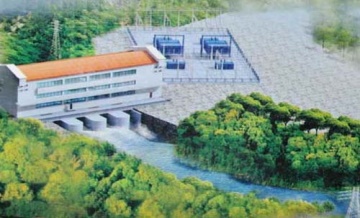GEORGETOWN, Guyana– The Guyana government says it has been informed by China Railway that it cannot enter into a Build Own Operate Transfer (BOOT) model to construct the US$700 million Amaila Falls Hydropower project and that could push the date for the completion beyond 2027.
“The negotiations are tough, and as of April 22nd, they wrote us saying that they are having a hard time making the boot contract and they want to shift to an EPC (Engineering Procurement and Construction) plus finance; that the government finances the project and then they would be the EPC contractor,” Vice President, Bharrat Jagdeo, told a news conference on Monday.
Artists’ impression of Amaila Falls Hydropower project
China Railway had emerged as the preferred bidder to open negotiations, and Jagdeo told reporters that talks continued with the Irfaan Ali government to convince the company to stick with the BOOT option since switching to an EPC model would require the project to be retendered.
“It’s a last-ditch attempt to save the model,” he said.
China Railway had been evaluated by the National Procurement and Tender Administration Board (NPTAB) as the most responsive bidder with an offer to build the Amaila Falls Hydropower Project out of its pocket, operate the facility, and sell Guyana Power and Light (GPL) electricity at 7.7 US cents per kilowatt-hour.
Jagdeo, however, ruled out opening negotiations with the second-ranked bidder because the cost of electricity sale to Guyana Power and Light Incorporated (GPL) is pegged at 9.9 cents per kilowatt-hour, and that would be uncompetitive when compared to the projected cost from the proposed natural gas-powered electricity station to be built at Wales, West Bank Demerara.
During the pre-2015 period, the Amaila Falls Hydropower project had proposed to sell the electricity to the grid at just over 0.10 cents per kilowatt-hour when the fossil fuel-generated electricity was at 0.20 cents per kilowatt-hour.
But, with the gas-to-energy project expected to supply power at six to seven US cents per kilowatt-hour, the cost can no longer be 0.20 cents.
“We have another source for generating power that is significantly cheaper, the cost, and so that is the key questi0n so you don’t want to lock in at say 10 cents per kilowatt-hour for the next 20 years when we can get it maybe 6-7 cents per kilowatt-hour maximum from the gas-to-energy project,” Jagdeo added.
Jagdeo acknowledged that in light of the current status of the negotiations and the possibility of switching to an EPC model, the 165-megawatt Amaila Falls Hydropower station could no longer be completed by 2027.
“We will have to revise timelines, but that will not affect our commitment to drop the price by 50 percent because the commitment was based on the power supplied from the gas-to-energy project, so the timeline is firm,” he said.
He also hinted that the Amaila Falls Hydropower project might be some way off should the current talks with China Railway collapse.
“We may even have to consider whether we’d have to bring in or do more from gas in the shorter term until we get a favorable project,” he said.























































 and then
and then